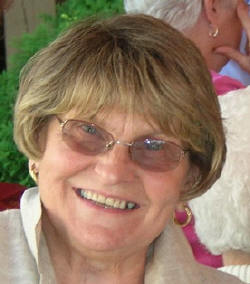Betty Jakum
Adams County Master Gardener

Recently, I came across some early blooming chrysanthemums for sale at a local garden center. Here was the first trickling of a tidal wave of vividly-colored chrysanthemums that will soon inundate greenhouses, nurseries and garden centers everywhere. From September through November these flowers treat us to a palette of bold colors that signal and celebrate the end of another growing season.
Chrysanthemums, being the color of autumn, have always been a favorite, but recently I’ve begun searching for something more long-lasting than the ones I’ve tried overwintering in the past. Most of these attempts have failed, even though I buy the ones marked ‘hardy’. Recently, in my search for a truly hardy chrysanthemum, I found one that hopefully will come back year after year. It’s a soft-colored, demure, unpretentious plant called a Sheffield Daisy, a variety that’s name and physical appearance denies any connection with what we generally think of as a chrysanthemum. I’ve had it in my garden for five years now, and from all indications it’s due to bloom again this fall.
Chrysanthemums are part of a large family of plants that’s cultivation has been noted in Chinese writings from 3000 years ago. Most are hybrids that originated from species native to places like Russia, China, and Japan. Early hybridization of these plants occurred in China as far back as 500 years ago. Today there are literally thousands of cultivars.
The boldly colored chrysanthemums we see everywhere as the weather cools and the more retiring Sheffield Daisies are surprisingly both perennials. However, planting the former in the ground, often after its fall display fades sometime in October or later, doesn’t allow sufficient time for the plant to become established. The plant’s entire life has been focused on developing its magnificent flowers with little regard to root development. Add to that the approaching winter when growth stops and the freezing and thawing of the soil that often heaves plants out of the ground, and it has little chance at surviving. Sheffield Daisies on the other hand are chrysanthemums that are planted in the spring. You will not find them for sale in the fall. To add to the confusion even further, nurseries usually place Sheffield Daisies with their perennials, if they carry them at all, while the fall blooming mums are thought of as throwaway annuals.
A popular variety of this chrysanthemum is Chrysanthemum x rubellum ‘Clara Curtis’. Called hardy mum, heritage mum and old-fashioned mum, it has long been the most popular chrysanthemum in colder climates due to its tough-as-nails habit. Its background remains a mystery (taxonomists keep changing its botanical name), but that doesn’t stop it from being an easy-to-grow garden mum, well adapted to zones 3 to 9.
It has deeply cut, middle-green leaves, a rather open habit and single daisy like flowers. It’s also a bit of a spreader, thanks to creeping rhizomes, and can be floppy if grown in other than full sun. It’s a vigorous grower that benefits from division every 2 to 3 years. The deer resistant flowers are long blooming and fragrant and attract butterflies. It grows 2 to 2 ½ feet tall and can spread to well over 3 feet in diameter. Other popular cultivars of this species are ’Mary Stoker’ (apricot yellow), ‘Princess Margaret’ (bright pink), Duchess of Edinburg’ (dark pink) and ‘Sheffield’ (pale pink).
Sheffield Daisies are perfect in sunny mixed beds and borders, preferring organic, well-drained soil in full sun in colder regions and at least half a day of sun in the south. They are perennial workhorses, especially for the fall garden when flowering plants are fading. They combine well with asters, Japanese anemones, goldenrod and fountain grasses. They require minimum maintenance. Cut back dead stalks each spring. Plants grown in lean soil benefit from an application of balanced fertilizer (10-10-10) or composted manure in late spring. To control height or lankiness, pinch plants’ tips back to desired height from Memorial Day until July 4th.
Don’t be surprised if you go looking for Sheffield Daisies and are greeted with quizzical looks. Arm yourself with exact information and let your favorite nursery know you are interested in purchasing perennial chrysanthemums. Granted, Sheffield Daisies are not the easiest plants to find. If they’re mums, why are they called daisies? We all associate mums with the fall, so why are we planting Sheffield Daisies in the spring? Why are chrysanthemum producers partial to varieties that provide bold, eye-catching colors yet ignore the more modest Sheffield Daisies that do the same thing if not so boldly? I think we all know the answer to that one.
I received my first Sheffield Daisies from a friend who had cuttings to share, a kind of pass-along thing where I seem to acquire some of my best plants. She had bought one small cutting at the Littlestown Area Garden Club’s annual Fall Plant Sale, and over time it had grown and spread to the point of needing dividing. My cuttings are now reasonably sized plants that will provide fall blooms from late October on. Years without an early killing frost can find my Sheffield Daisies blooming till Thanksgiving.
Read other articles on garden and landscape design
Read other articles by Betty Jakum